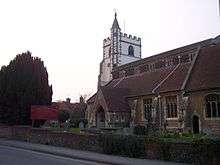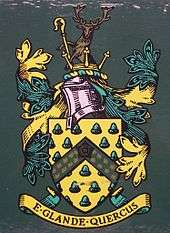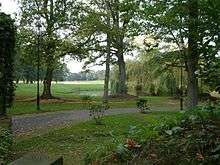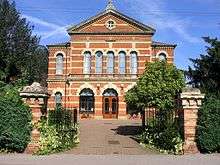Wokingham
| Wokingham | |
|---|---|
 Wokingham Town Hall | |
 Wokingham | |
| Wokingham shown within Berkshire | |
| Area | 0.9 sq mi (2.3 km2) |
| Population |
30,403 (2001) 30,690 (2011 Census)[1] |
| • Density | 33,781/sq mi (13,043/km2) |
| OS grid reference | SU8068 |
| • London | 39 mi (63 km) ENE |
| Civil parish |
|
| Unitary authority | |
| Ceremonial county | |
| Region | |
| Country | England |
| Sovereign state | United Kingdom |
| Post town | WOKINGHAM |
| Postcode district | RG40, RG41 |
| Dialling code | 0118 |
| Police | Thames Valley |
| Fire | Royal Berkshire |
| Ambulance | South Central |
| EU Parliament | South East England |
| UK Parliament | |
| Website | Wokingham Town Council |
Wokingham is a historic market town in Berkshire, England, 39 miles (63 km) west of London, 7 miles (11 km) southeast of Reading, 8 miles (13 km) north of Camberley and 4 miles (6.4 km) west of Bracknell. At the 2011 census, it had a population of 30,690.
Wokingham was a borough before the 1974 reorganisation of local government, when it merged with Wokingham Rural District to form the new Wokingham District. Borough status was granted in 2007.[2]
History

Wokingham means 'Wocca's people's home'.[3] Wocca was apparently a Saxon chieftain who would also have owned lands at Wokefield in Berkshire and Woking in Surrey. In Victorian times, the name became corrupted to Oakingham, and consequently the acorn with oak leaves is the town's heraldic charge, granted in the 19th century.
The courts of Windsor Forest were held at Wokingham and the town had the right to hold a market from 1219. The Bishop of Salisbury was largely responsible for the growth of the town during this period. He set out roads and plots making them available for rent. There are records showing that in 1258 he bought the rights to hold three town fairs every year.[4] Queen Elizabeth granted a town charter in 1583. From the 14th to the 16th centuries, Wokingham was well known for its bell foundry which supplied many churches across the South of England.
During the Tudor period, Wokingham was well known as a producer of silk. Some of the houses involved in these cottage industries are still to be seen in Rose Street. The houses with the taller ground floors housed the looms. This can be seen from the position of the exterior beams of the houses. It is said that one of the original mulberry bushes (favourite food of the silk worm), still remains in one of the gardens.
In the years 1643–44 Wokingham was regularly raided by both sides in the Civil War. These raids would involve the looting of livestock and trading goods, and over thirty buildings were burnt down, accounting for nearly 20% of buildings in the town at that time.[4] It was not until the early 18th century that Wokingham had fully recovered.
Wokingham was once famous for its bull-baiting. In 1661 George Staverton left a bequest in his will giving two bulls to be tethered in the Market Place and baited by dogs on St. Thomas' Day (21 December) each year. The bulls were paraded around the town a day or two before the event and then locked in the yard of the original Rose Inn which was situated on the site of the present-day Superdrug store. People travelled from miles around to see the dangerous spectacle. A number of dogs would be maimed or killed during the event and the bulls were eventually destroyed. The meat and leather were distributed amongst the poor people of the town. Some of the spectators also sustained fatal injuries. In 1794 on the morning after the bull-baiting Elizabeth North was found dead and covered with bruises. In 1808, 55-year-old Martha May died after being hurt by fighters in the crowd. The cruel 'sport' was prohibited by the Corporation in 1821 but bulls were still provided at Christmas and the meat distributed to the poor. Bull-baiting was banned by Act of Parliament in 1833.
In 1723, the 'Black Act' was passed in Parliament to make it an offence to black one's face to commit criminal acts. It was named after an infamous band of ruffians, known as the 'Wokingham Blacks', who terrorised the local area until 29 of them were arrested after fighting a pitched battle with Grenadier Guards in Bracknell.
Historically, the local accent could be described as a blend of traditional London Cockney, influenced by aspects of West Country pronunciation. However, the rapid expansion of the town, and subsequent influx of non-locals, has led to a decline of this speech pattern since the 1970s. In the 21st Century, traditional Wokingham accents are becoming rare, particularly amongst young people, who are increasingly influenced by the spread of Multicultural London English.
The formerly important industry of brick-making has given way to software development, light engineering and service industries,and the population has greatly increased.
Governance

Northern Wokingham, centred on Ashridge, was, archaically, a detached part of Wiltshire. This area extended well into the town centre (and the area currently where the Dowlesgreen, Norreys and Bean Oak estates currently are situated) until transferred to Berkshire in 1844. The ancient parish was divided in 1894 into urban and rural civil parishes, Wokingham Without forming the latter.
Wokingham was one of the boroughs left unreformed by the Municipal Corporations Act 1835, and was reformed subsequently in 1883. Wokingham merged with the Wokingham Rural District in 1974 under the Local Government Act 1972 to form the non-metropolitan district of Wokingham, which has been a unitary authority area since 1998. It consists of 54 elected councillors and is presided over by one councillor who is elected annually to be the chairman of the council. Elections to the council are held in three out of every four years, with the Conservative party having had a majority since the 2002 election.[5] The Borough Council Offices are based at Shute End in the town of Wokingham.
A successor parish continued in existence in Wokingham and is governed by Wokingham Town Council. The council is elected every four years and consists of twenty-five councillors representing Emmbrook, Evendons, Norreys and Wescott, the four wards of the town. Every year, they elect one of their number as mayor. The present town hall was erected in 1860 on the site of the guildhall.
The Wokingham constituency's MP is the Conservative John Redwood, who has represented it since 1987.
Geography

Wokingham is on the Emm Brook in the Loddon Valley in central Berkshire situated 33 miles (53.1 km) west of central London. It sits between the larger towns of Reading and Bracknell and was originally in a band of agricultural land on the western edge of Windsor Forest. The soil is a rich loam with a subsoil of sand and gravel.
Wokingham has a town centre, with main residential areas radiating in all directions. These include Woosehill to the west, Emmbrook to the northwest, Dowlesgreen, Norreys, Keephatch and Bean Oak to the east, and to the south Wescott and Eastheath. Older names include Woodcray and Luckley Green.
Much of Wokingham has been developed over the past 80 years. Woosehill and Dowlesgreen were built on farmland in the late 1960s and early '70s, along with Bean Oak. Keephatch was built in the early '90s. The Norreys Estate was built in the 1960s; however, Norreys Avenue is the oldest residential road in that area, having been built in the late 1940s as emergency housing following the Second World War. Norreys Avenue has a horseshoe shape and occupies the site of the demolished Norreys Manor. Much of the road contains 1940s-style prefabricated houses, although there are some brick houses along with three blocks of 1950s police houses.
In 2010, the council set up WEL (Wokingham Enterprise Limited) to manage a £100m regeneration project to redevelop the town centre with new retail, leisure and residential facilities, parking, roads and open spaces.[6]
Several major expansion projects around the town are planned over the next decade, including a major redevelopment of the town centre, new north and south relief roads and at the former military base at nearby Arborfield Garrison. As of 2015, the redevelopment of the railway station and surrounding area is complete, and large scale housing construction is underway to the north-east and south-east of the town.
Transport
Wokingham railway station is at the junction of the Waterloo to Reading line with the North Downs Line. South Western Railway manages the station and provides services along with Great Western Railway.[7]
Most local bus services are provided by Courtney Buses but the services from Wokingham to Reading and Bracknell are operated by Reading Buses after First Berkshire & The Thames Valley closed their Bracknell depot in the summer of 2015. There is also a football bus run on Reading FC match days by Stagecoach South to the Madjeski Stadium.
Institutions
Charities
- The Lucas Hospital, almshouses founded in 1663 for sixteen elderly men from the surrounding parishes.
- Wokingham United Charities providing grants to people living within the Wokingham area relieving poverty, hardship and distress. Also providing sheltered accommodation for local people.
- The Rotary Club of Wokingham is part of Rotary International. The club members engage in fund raising activities and distribute the money collected to worthy causes both locally and worldwide.
Churches

- All Saints' Church (CofE), transformed from a chapel-of-ease of Sonning in 1190
- Corpus Christi Catholic Church
- St. Paul's Church (CofE), built by John Walter III in 1864
- Wokingham Baptist Church
- Wokingham Methodist Church
- ChristChurch Wokingham (CofE)
- Woosehill Community Church
- Norreys Church
- Kings Church Wokingham
Manors
- Evendon's Manor
- Ashridge Manor (now in Hurst, Berkshire)
- Beche's Manor (burnt down 1953)
- Keep Hatch (Built 1871–74, demolished late 1990s due to dereliction to make way for the Keephatch housing estate)
- Buckhurst Manor (now St. Anne's Manor)
- Norreys' Manor (demolished long ago, now Norreys Avenue)
Education
Secondary schools
Wokingham is served by four state secondary schools. The Emmbrook School is a mixed-sex comprehensive school, a Maths and Computing College, St Crispin's School is a mixed-sex comprehensive schools, which is a Maths and Computing Colleges. The Holt School, founded in 1931 in the Dower House of Beche's Manor, is a girls' school and a Language College and Science College. The Forest School is a boys' school and a Business and Enterprise College.
Private schools
- Holme Grange School founded in 1945 for Girls and Boys aged 3–16 years
- Luckley House School founded at Luckley House in 1918 for girls aged 11–18
- Ludgrove School, moved to Wixenford House in 1937
- White House Preparatory School, for girls aged 2–11, now closed
- Reading Blue Coat School, is the oldest school in Wokingham Borough founded in 1666. A boys school until the age of 16 when it becomes a mixed sixth form. Blue Coat has been located in the village of Sonning since 1946 and has a catchment area of most of Berkshire and South Oxfordshire.
Literature
In the 18th century, the Ballad of Molly Mogg was written in Wokingham. Molly was the barmaid daughter of the publican of the old Rose Inn (not on the site of the present one). She was well-known to local Binfield man, Alexander Pope, who, during a storm, found himself stranded at the inn with his friends, Gay, Swift and Arbuthnot. They wrote the ballad extolling her virtues to pass the time.
The character of Tom the chimney sweep in Charles Kingsley's classic childhood story The Water Babies was based on the life and times of a Wokingham boy called James Seaward, who was a boy sweep in Victorian times. In his later years Seaward swept the chimneys at Charles Kingsley's home at the Rectory in Eversley, Hampshire. Seaward was elected Alderman of Wokingham from 1909 until his death in 1921. He had 12 children and many of his descendants still live locally. The Water Babies are the subject of Wokingham's first public sculpture, installed in 1999, which graces the upper level entrance to Wokingham Library.
Modern notoriety
In 1984, Mark Tildesley, a seven-year-old schoolboy, disappeared after leaving home to go to the fairground. His body has never been found. The case remains unsolved despite being featured heavily in the national press and on BBC TV's Crimewatch.[8]
Film
Soldier Soldier's season 7 was filmed at Bearwood College, which was the scene for the parade ground, officers' mess, and a school.[9]
Sport and leisure
- There are public parks at Barkham Road Recreation Ground, Langborough Recreation Ground, Cantley Park, Chestnut Park, Elizabeth Road Recreation Ground, Elms Field, Riverside Walk and Waverley Park.
- There is a local nature reserve called Holt Copse & Joel Park.[10]
- The council provide a number of leisure facilities such as the Carnival Pool, St. Crispin's Sports Centre and the Pinewood Leisure Centre. Pinewood is the base for over 20 clubs and associations. There is a King George V Playing Field behind St. Crispin's in memory of King George V.
- The local football team is Wokingham and Emmbrook F.C.
- The Wokingham Half Marathon is held each February and starts and finishes at Cantley Park.
- Wokingham Library is in Denmark Street.
- Wokingham Cricket Club (founded 1825) played at their ground on Wellington Road before relocating to a new, bigger ground in Sindlesham in 2012.
- Wokingham Music, Food & Drink Festival is held every August. Showcasing local musicians, local food producers and also wines, beers, and ciders from Berkshire and surrounding breweries.[11]
- Wokingham Open Air Cinema. For its second year three films were shown the weekend before the Wokingham Festival.[12]
Speedway racing was staged at California in Reading.[13] Before then the track, known then as Longmoor was used as a training track.[13] After the war the track featured in the Southern Area League in the 1950s.[13] The team were known as the Poppies.[13] The site of the stadium is now part of a nature reserve but a few remnants of the track remain.
Twin towns
Wokingham is twinned with:
-
 — Erftstadt in Germany
— Erftstadt in Germany -
 — Viry-Châtillon in France
— Viry-Châtillon in France
Notable people
- Charlie Austin, Southampton striker
- Luke Bedford, composer
- Thomas Bradley, chaplain to King Charles I
- Sir Richard Browne, 1st Baronet of London
- Kate Bryan, arts broadcaster
- The Cooper Temple Clause, post-hardcore punk band
- Isaac Deutscher, Polish historian and political activist, lived in Wokingham from the late 1950s to 1963.
- Claude Duval, highwayman, owned a house in the town
- Dick Francis, writer
- Thomas Godwin, Bishop of Bath and Wells, born and died in Wokingham
- Nicholas Hoult, actor and model, best known for his roles in the films About a Boy (2002) portraying Marcus, X-Men: First Class (2011) portraying Hank McCoy and for portraying Tony Stonem in the E4 drama series Skins (2007–2008)
- Daniel Howell, YouTuber, author and BBC Radio 1 presenter
- Stephen Hughes, footballer, born in Wokingham
- Diane Kendal, makeup artist
- Steven Lewington, professional wrestler formerly known as "The British Babe", now wrestling as "DJ Gabriel" with WWE
- Frederick Lucas, founder of The Tablet
- Henry Lucas, founder of the Lucasian Professorship of Mathematics at Cambridge University
- Sir Henry Marten, Judge of the Admiralty Court
- Leslie Sears, cricketer
- Russell Slade, football manager
- Anne Snelgrove, MP
- Bill Stone, veteran of both World Wars; lived in Sindlesham
- William Talman, architect and landscape designer
- John Walter III, local benefactor and proprietor of The Times newspaper
- Anna Watkins, gold medallist at the 2012 London Olympics and bronze medallist at the Beijing Olympics in 2008 in the women's double sculls[14]
- Jason Watkins, actor
- Will Young, singer and Pop Idol's Series 1 (2002) winner
References
- ↑ "Civil Parish population 2011". Neighbourhood Statistics. Office for National Statistics. Retrieved 30 November 2016.
- ↑ Wokingham granted borough status BBC news online, 26 January 2007
- ↑ Ford, David Nash. "History of Wokingham in the Royal County of Berkshire". Britannia. Retrieved 25 October 2011.
- 1 2
- ↑ "Wokingham". BBC News Online. 19 April 2008. Retrieved 17 January 2010.
- ↑
- ↑ "Wokingham Station". National Rail.
- ↑ "Latest Wokingham news for the town and borough - getreading".
- ↑ "Soldier Soldier". 10 June 1991 – via IMDb.
- ↑ "Magic Map Application". Magic.defra.gov.uk. Retrieved 2017-04-29.
- ↑ "Beer | Wokingham Food & Drink Festival". Wokinghamfestival.co.uk. Retrieved 22 April 2013.
- ↑ "Wokingham Open Air Festival - 2015".
- 1 2 3 4 "memoire-t_stubberfield-02". Arborfield-september49ers.co.uk. Retrieved 2017-04-29.
- ↑ "Latest Wokingham news for the town and borough - getreading".
Further reading
- Goatley, K. Wokingham: The Town of my Life. Reading: Conservatree Print and Design, 2004. ISBN 0-9534735-9-7.
- The Wokingham Society. Wokingham: A Chronology, 1978.
- Wyatt, B. Wokingham in Old Photographs. Stroud, Gloucestershire: Budding Books, 1999. ISBN 1-84015-128-5.
- Harison, J. Living Heritage – 300 years of bells, ringing and bellringers at All Saints Wokingham, 2009. ISBN 978-0-9563740-0-4.
- Bell, J. "Memories of Wokingham Town Hall 1860 to 1946"
- Bell, J. "Wokingham and the Royal Jubilees"
- Bell, J. "Former Mayors of Wokingham 1885 to 1946"
- Bell, J. "Former Mayors of Wokingham 1947 to 1979"
- Bell, J. "A Stroll Through St. Paul´s Churchyard"
- Bell, J. "St. Paul´s Wokingham - Early 20th Century Parish Magazine Extracts"
- Bell, J. "St. Paul´s Parish Wokingham at War 1939-1945"
- Bell, J. "the Memorials Inside All Saints' Parish Church"
- Bell, J. "the Story of H.M.S. Garth"
- Bell, J. "St. Paul´s Parish Church, Wokingham"
- Bell, J. "Miss Winifred Spooner, Aviatrix"
- Bell, J. "Wokingham Remembers the Second World War"
- Bell, J. "High Stewards of Wokingham"
- Bell, J. "Five Wokingham Families"
- Bell, J. "Former Town Clerks of Wokingham"
External links
| Wikimedia Commons has media related to Wokingham. |
| Wikisource has the text of the 1911 Encyclopædia Britannica article Wokingham. |